It’s All Meat | Interview | “Canadian Heavy Psych Monster”
It’s All Meat was formed in Toronto, Ontario, Canada in 1969. Columbia offered them a deal and an LP soon followed in 1970.
The roots of It’s All Meat comes from a garage rock band called The Underworld. Rick McKim and Jed MacKay weren’t in Underworld, but produced their single, ‘Bound’ / ‘Get Away’. Members of It’s All Meat were Wayne Roworth on guitar, Norm White on guitar, Rick Aston on bass and vocals, Jed MacKay on organ, piano and lead vocals and Rick McKim on drums.
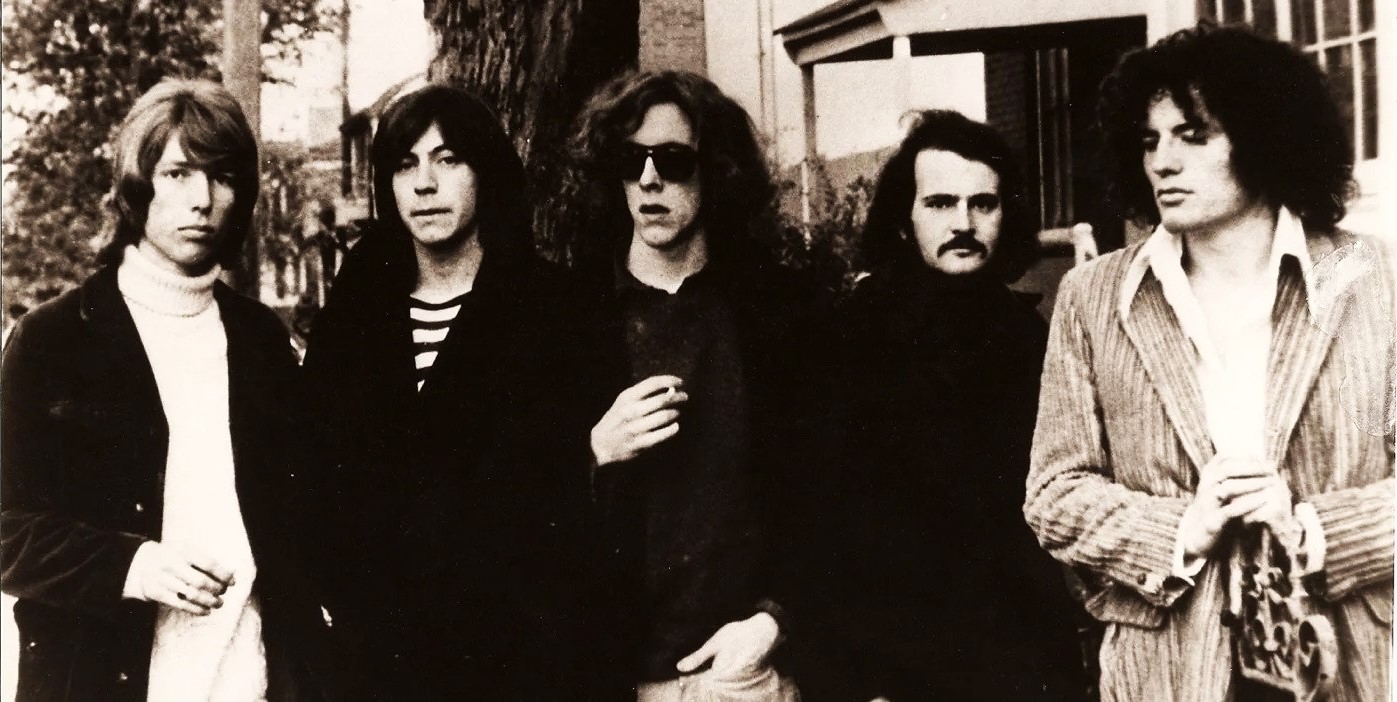
“We were a tightly rehearsed band and recorded the entire album in three four-hour sessions”
You’re originally from a small town of Maple, north of Toronto, Ontario, Canada. Would you like to tell us about your childhood? What was it like to live there and when did you first get interested in music?
Wayne E. Roworth: I lived in a small town called Maple some miles north of Toronto, Ontario, Canada. A typical self sufficient town with a few churches, elementary schools, small stores and a community center with a bowling alley. I remember when I was about ten we used to, after school, get on our bikes and ride out to a barn in a local farmers field and chase the girls for a kiss. Every Friday night I would work as a “pin boy” at the bowling alley where they did not have automatic pin placement. You had to be careful when setting the pins by hand because some old ladies could not count and they would throw a bowling ball at you while you were setting the pins up! I had a 45 record player in my bedroom and would play a lot of The Beatles, The Doors, Jimi Hendrix Experience and The Who. While learning how to play guitar I would use a self teaching album released by The Ventures where you could learn how to play the chords to each song like ‘Walk Don’t Run’ and ‘Tequila’. I took it further to learn the lead by ear. I discovered I could move on to more difficult popular songs and could learn them by ear as well.
“I think that what you could say changed my life in music was when The Beatles ‘Sgt. Pepper,’ Jimi Hendrix and Led Zeppelin all hit the scene within a 12 month period”
Was there a certain moment in your life that made you want to become a guitar player? When did you begin playing?
I think every person wants to emulate their hero. My heroes were George Harrison, The Ventures, Duane Eddy, Jimi Hendrix, Pete Townsend to name a few. The very first song I heard and wanted to learn was the theme from the TV series Bonanza. I found out you could play the main lick without touching the fretboard! There’s something about playing a guitar. It becomes an extension of your body. My first guitar was a hollow body Harmony with no pick ups my dad bought me when I was twelve. ‘Bonanza,’ ‘Walk Don’t Run,’ ‘Act Naturally’ were some of the songs I learned and played. In my teens I had a Sears lipstick electric, a Vox VG4 Semi-Hollowbody and a Fender Telecaster where I stripped the paint down to the wood. It becomes an extension of your body. I’ve had many fans over the years tell me the guitar I am playing is like a “third arm.” My dad became interested in playing during those years and he bought a used Rickenbacker 12 string. I played that guitar on the It’s All Meat album. I think that what you could say changed my life in music was when The Beatles ‘Sgt. Pepper’s Lonely Hearts Club Band,’ Jimi Hendrix and Led Zeppelin all hit the scene within a 12 month period. That was literally mind blowing.
Were you in any bands before beginning with It’s All Meat?
I would search the neighborhood for anyone who wanted to play music with me. There were a few local friends who would rehearse with me in my parents basement. We would go out and play the local community hall on weekends, the same one I worked as a pin boy, and play a few sets. This was my first experience being up on stage. I felt right at home and this is where I wanted to be. When I started high school, which was in another town, I met up with a new crowd. I found new people to play with. I don’t remember the band names but we did play at my high school. The same high school I played with It’s All Meat years later. The songs were all cover songs in cover bands. During those years I could not find musicians with any skill levels matching mine until I hooked up with It’s All Meat.
How did you originally meet Jed MacKay and Rick McKim?
I was playing a 1969 Gibson Custom Gold Top and was eighteen years old and was looking for better players when I answered an ad in the Toronto Star paper for a guitarist. Jed MacKay, keyboard player, lead vocalist and Rick McKim drummer were forming a band. I showed up with both the Les Paul and the 12 string Rick at a church somewhere in Toronto. We jammed a bit then Jed wanted me to improvise on a song he and Rick had written called ‘Crying Into The Deep Lake’. For some reason I picked up my dad’s Rickenbacker and picked out a melody in G. Jed said later that “moody” picking landed me the spot. Also my lower frequency Les Paul was a good contrast to Norm White’s Stratocaster. I loved Rick Aston’s nylon strings on his Rickenbacker bass. Rick McKim impressed me as a drummer. He was one of the best drummers I have ever played with and I have played with some good ones such as Shawn Fichter who is now with Tim McGraw. We all seemed to get along very well and all were very good improvisers to the music written by Mackay and McKim.
So if I understand correctly they were originally starting the band and you were the last to join the band?
Yes. I was the last member to join. The band had been rehearsing prior to me and it made me very comfortable. All I had to do was put my thing on it. It reminds me of listening to great music in my bedroom on my record player and putting my things on the music.
How did you get manager Jack London? He’d had a hit as Jack London and the Sparrows. Some of the Sparrows went on to become Steppenwolf?
According to Jed MacKay we were rehearsing in an old bank building on the corner of King St and Sherbourne in Toronto. Jack was passing by and stopped to listen. Jack immediately took to our sound. There was really nothing like it in Canada during that period. Our manager at the time, John Pepperell, felt he couldn’t devote enough time to us, so we made the switch. John continued with us as part of Mind’s Eye, creating all our graphical effects at all of our shows. Back then you would use multiple overhead projectors. Place two clear slides on the lens then squirt colored liquid between the slides and move the two slides around. The colored effect was projected onto the stage. Very PSYCHEDELIC! Jack London evolved from Jack London and The Sparrows. This band had a minor hit called Sparrows and Daisies. Two members from this band went on to become Steppenwolf. For It’s All Meat live shows Jack would come in in a suit and bowler hat to introduce the band. It’s All Meat could not wait through these long introductions and typically blasted Jack off the stage with the beginning of Feel It! Jack did secure the Columbia record deal for It’s All Meat.
What kind of gear, instruments and amps did you have in the band?
For live shows the guitar and bass players played through Traynor 2 x 12” with 100 watt heads. Norm White used two heads, one driving the other. Jed had a Gibson 101, which was kind of an early Farfisa/synthesizer hybrid – complete with a toggle that could bend notes. He used a Traynor amp and column speakers. Rick McKim used Gretsch drums and Zildjian cymbals. For the album we all used 100 watt Marshall heads with double stack 2 x 12”. Norm White played a 64 Stratocaster on all of our recordings. Rick Aston, (Raston), played a 67 Rickenbacker bass with nylon strings on all recordings. I played a 68 Gibson Les Paul Goldtop on our first single Feel It and a 69 Gibson SG Custom and Rickenbacker 12 string on the album and second single ‘You Don’t Notice The Time You Waste’.
Was there a certain overall vision you had when starting the band?
According to Jed MacKay, he and Rick McKim had been in a band called The Easy Riders, which played rock/folk/r’n’b covers predominantly. Rick and Jed had been writing songs, but only a couple fit the future repertoire. After the band broke up in the spring of 1967, Rick and Jed decided to start another band which would be more adventurous musically. In the few short months between bands, the world had seen the explosion of the San Francisco bands, and Jimi Hendrix had revolutionized guitar playing. Rick and Jed were inspired by that. In keeping with the times, some songs were actually suites, and incorporated multiple time signatures just for fun. (‘Feel It’ began life as a 17 minute opus called ‘Have You Got The Time For Me,’ for example, which had segments in 3/4, 4/4, 5/4, 7/4, and 9/4. A remnant of the 5/4 part can be heard in the tag to the ‘Feel It’ single). In the early gigs, Rick and Jed also incorporated spoken word recordings, edited to fit the music. Musically, they wanted to embrace as many genres as they could.
There must be a story behind the band’s name?
Jed MacKay was watching TV late one night and saw a dog food commercial which boasted the product was “all meat, no filler”. He liked that idea and It’s All Meat became a reality.
How did you get signed to Columbia? Did Jack London secure the deal?
That was all Jack London’s doing. He believed in us and really moved things along.
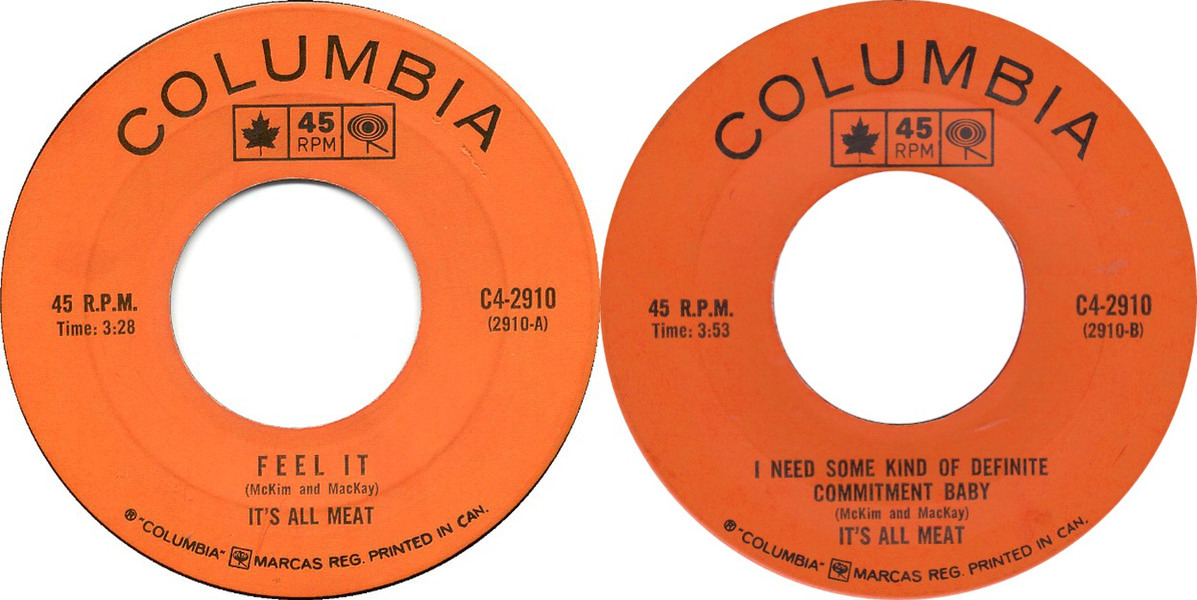
Where did you play some of the early shows? What bands did you share stages with and what did your early repertoire look like?
We had a home base called The Cosmic Home in North Toronto. It was a small club which was standing room only every time we played there, which was a couple times a week. That club created our fan base. Other early venues were my high school, colleges and outdoor festivals. It’s All Meat was primarily a solo act. When and if we shared a stage with any other act our very loud dynamic sound and stage presence dominated the evening and dwarfed the other bands. Fact not bragging. Our early repertoire consisted of a bunch of originals which were later recorded and covers of songs like ‘Under My Thumb’ by The Rolling Stones, ‘Not So Sweet Martha Lorraine’ by Country Joe and the The Fish, ‘Run Run Run’ by the Velvet Underground, ‘Time and Again’ by Earth Opera, and Bo Diddley’s classic ‘Who Do You Love’.
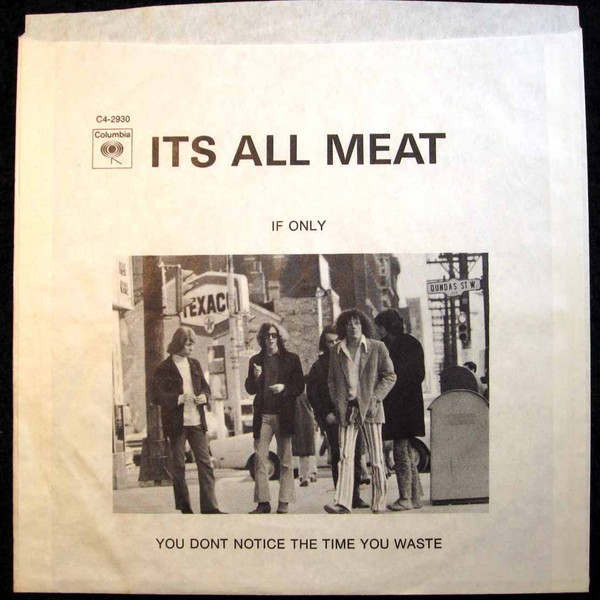
When exactly would you say the band formed?
Jed MacKay and Rick McKim started talking about it in the fall of 1967, and began putting it together in early 1968.
What’s the story behind your debut album? Where did you record it? What kind of equipment did you use and who was the producer? How many hours did you spend in the studio?
Before the album we released our first single, A side ‘Feel It’ and B side ‘I Need Some Kind Of Definite Commitment’. That release was recorded at Eastern Sound Studios, Toronto, Canada. We used our live stage equipment for that recording. After that record we fine tuned the album at our live shows. We also rehearsed every day. There was no jamming. Every rehearsal had structure and purpose. The album was recorded in RCA Victor studios in Toronto, Canada. Bill Misener was the producer, and it was engineered by Mark Smith, assisted by Hayward Parrot. We all had 100 watt double stack Marshalls for those sessions. We were a tightly rehearsed band and recorded the entire album in three four-hour sessions. The only overdubs were vocals and piano.
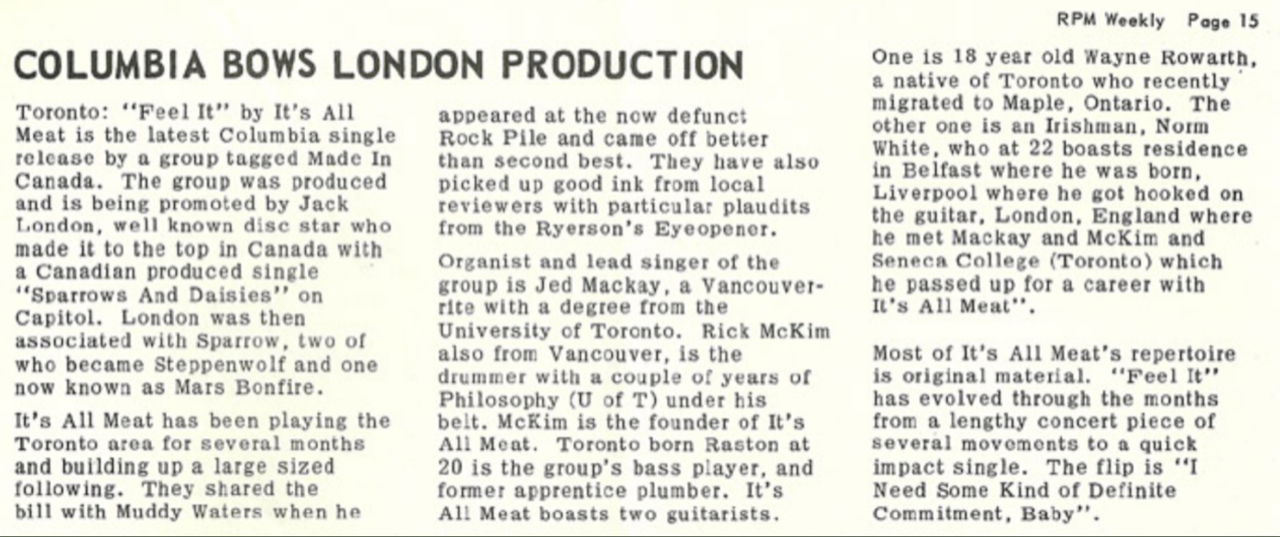
Did the size of audiences increase following the release of your debut? Did you get a lot of airplay? What about the press?
In 1969, singer/songwriters playing their relatively gentle music were coming to the fore. In contrast we were a LOUD dynamic band with boundless energy. Our volume and pummeling rhythms were a tough sell. In addition the Canadian market was virtually non-existent and the U.S. market was impenetrable. We received airplay from FM stations – which had emerged (along with stereo) in 1967 – but couldn’t get any AM traction. We definitely got more gigs after the LP release. And we had a cadre of really devoted fans, who we loved. They were the only ones who really got it back then. Over the years there have been countless publications asking the question why did this band not make it? It’s comforting to know that there are many fans today who also get it! The large Toronto papers covered us lightly. They had no idea what It’s All Meat was or why they were so loved. Typical back then.
Any ideas how many copies did Columbia press?
We were not given any numbers. I do know that the original album is rare. If you can find an original one it will cost you upwards of $1000 US. The album has been re-released a couple of times. The first was on the Hallucinations label and is a full gatefold with additional not released tracks. I have heard that ‘Feel It’ will be re-released sometime in the future.
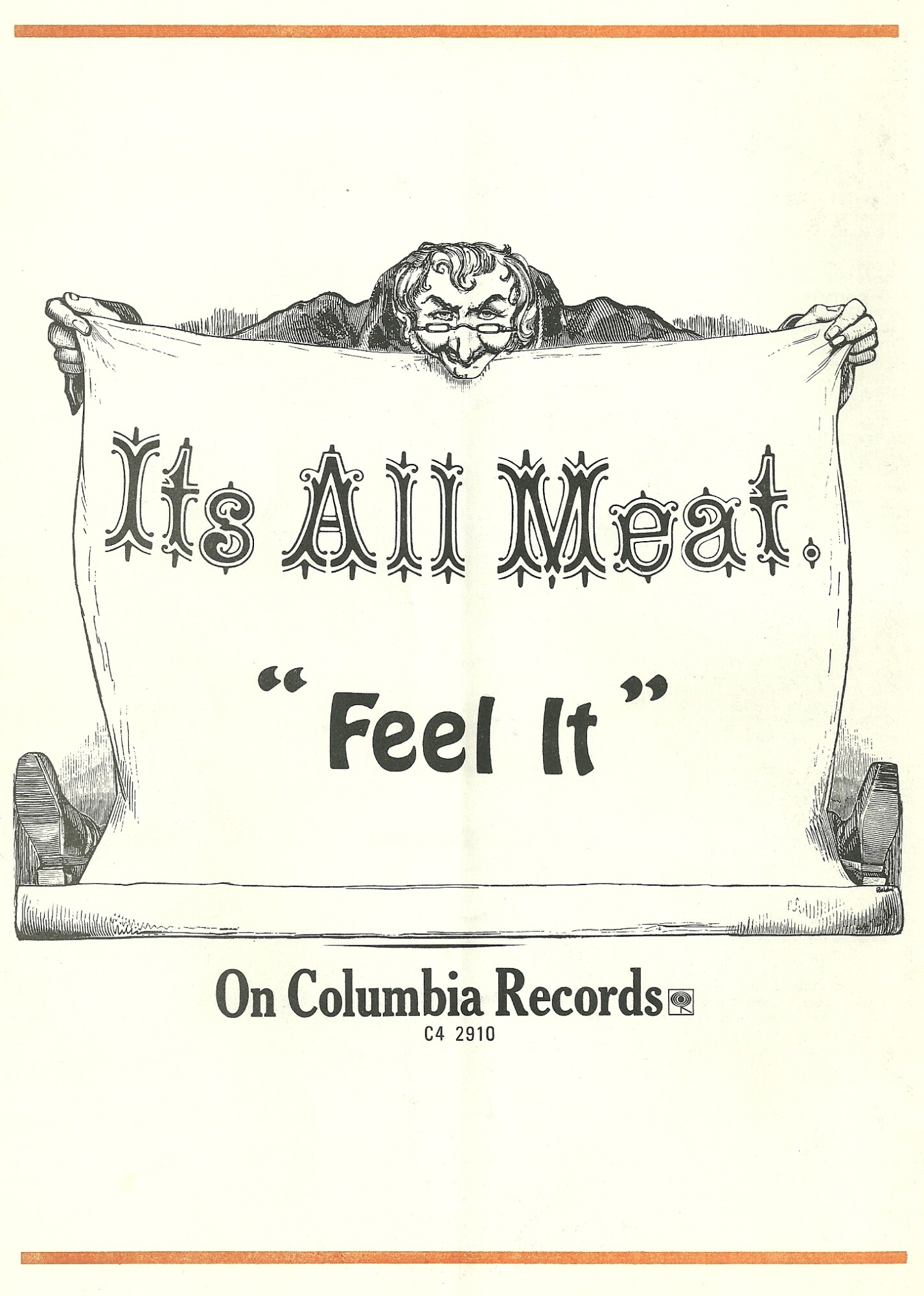
Was there a certain concept behind the album?
According to Jed MacKay and I, we wanted to introduce the various sides of the band. I think the way the players demonstrated their various skills on their varied instruments really helped develop the It’s All Meat sound. Every instrument had a unique sound and the way each player played it, a unique style. Each player could also improvise very well. One of our live show favorites was ‘Who Do You Love’ by Bo Diddley. Rick McKim would start the undercurrent with his toms. Each player would overlay each other along the way building to a great vocal chorus. This “building process” shows itself very well on the album.

Would you share your insight on the albums’ tracks?
The songs on the album were written over a period of two years, or so before we recorded them – only ‘Self-Confessed Lover’ pre-dated the band. The only “vision” we had for the album – and the ‘Feel It’ single – was to showcase the various facets of It’s All Meat. And of course we all drew our inspiration from a variety of sources. We worked out all of the songs with repeated rehearsals and performances so we could minimize the (expensive) time in the studio it would take to record them. As I recall, we recorded pretty well all the instrumental tracks in two sessions, and vocals and leads in another session. We were a tight, pummeling band rhythmically and really wanted the record to reflect that, plus our other sides. That’s why we put PLAY IT LOUD in caps on the cover – we were a loud band with power. I think the record got that across, particularly if it’s played loud!
‘You Don’t Notice The Time You Waste’
This was side A of our second single. The Rick 12 string was used here. It seemed to blend well with Jed’s keys giving a solid rhythm.
‘Make Some Use Of Your Friends’
This is a good example of what I term as a “rhythm lead” played on my SG Custom and almost like a second bass part. This technique works well when you have Jed playing the rhythm on keys. Norm White shines away with that classic Strat sound.
‘Crying Into The Deep Lake’
Jed MacKay: ‘Crying Into The Deep Lake’ and ‘Roll My Own’ were originally the last two segments of a four part suite. There wasn’t supposed to be a track break between them, but for some reason that couldn’t be accommodated on the recording.
Wayne E. Roworth: This is the song that landed me the gig with It’s All Meat. The Rickenbacker 12 string was used extensively throughout the album.
‘Roll My Own’
I wanted a low end Jefferson Airplane guitar feel with a screaming high end Jimmy Page to accelerate this tune. My SG didn’t let me down. I basically followed and replicated Jed’s vocals with some special twists!
‘Self-Confessed Lover’
I remember Jed saying to me when I first arrived at the studio he wanted me to sing ‘Self-Confessed Lover’. I never sang any of our songs live previously and it caught me off guard. I rehearsed in the men’s restroom! It always amazed me how quickly we got things done back then.
‘If Only’
This was side B of our second single. I think Rick Aston (Raston) sings this really well. Jed’s piano makes my playing so easy.
‘You Brought Me Back To My Senses’
This is one of my favorite tracks. I wanted to put some mystery behind my playing. Jed provided the background on the keys and I used my Gibson SG Custom through a Vox Wah Wah pedal which I left opened. This gave me a unique sound with just a touch of feedback. There’s one note that octaves and still puts a grin on my face.
‘Sunday Love’
This song reminded me of Ravel’s ‘Bolero’. Light, flowery 12 string lulls you to sleep until it lights up with some rock, fades again with the wah wah then builds on and upward with increasing tempo along with Norm’s haunting Strat, this song is incredibly strong.

How pleased was the band with the sound of the album? What, if anything, would you like to have been different from the finished product?
Jed MacKay: Overall, I was happy with it. I wish it could’ve opened with ‘Feel It,’ but that wasn’t possible for some contractual reason. I didn’t like Wayne’s lead being mixed so low in ‘Crying Into The Deep Lake,’ and I felt the chordal parts of Norm White’s solo in ‘Sunday Love’ were mixed muddily. But it felt like a good place to start.
Wayne E. Roworth: When we cut the album it was so fast and frenzied I never even had a chance to critique it. When I had the chance to actually take the time to listen to it I was generally pleased but there are a few mistakes by different members, including myself, that if I had heard those mistakes at the studio I would have done another take. I also think the album could have been mixed much better.
As you were part of the 60s, were you inspired by psychoactive substances like LSD at the time of writing the album? Or did you at least experiment with it?
Jed says he doesn’t think anyone who grew up in the 60’s didn’t at least experiment with stuff. Me, at the time, did not experiment until a few years later. Our material was precise and a little complex. You had to have your head together to perform it well.
What are some of the most memorable concerts you played?
Opening for Muddy Waters at The Rock Pile. We were a tough act to follow with the opening chord of ‘Feel It,’ 5,000 people knew it, screamed at us through a very loud set. You could hear a pin drop when Muddy Waters took the stage. Hearing the audience gasp when they recognized the opening chord of ‘Feel It’ at the start of an outdoor festival – I still don’t know how they knew it! I’d include the Baldwin Street outdoor festival as one of our memorable performances. The organizers called the police who pulled the plug because of complaints we were too loud! Not from the fans but from businesses way down the street. Another was The Hawks Nest. This club was partly owned by the legendary Ronnie Hawkins who was one of the founding members of The Band. But the best experiences were when we played at the Cosmic Home – our base. It was a nondescript, small venue in an unassuming middle class neighborhood, but there were so many hip kids there who were devoted fans of It’s All Meat. The club would be packed to the walls, sweaty, steaming hot, filled with incredible energy. Those fans inspired us all the way.
What would be the craziest gig or story you ever did?
It’s got to be the many gigs we played at The Cosmic Home. When we played there the fans gave us their energy and it seemed the room became one life force. I remember Norm White stabbing the headstock of his Strat into the white ceiling tiles and bits of tile would fall on people. He also used the mic stand as a slide, moving the guitar neck on the mic’s chrome pole. I remember Rick McKim used to hit his knuckles on the snare rim causing them to bleed. I have blood in one of my old guitar cases! Me and Norm went into my 1961 Comet to head out and there were women in the back seat. They said stuff like “I just wanted to hang with you and darn your socks.” Well they hung with us but I don’t remember my socks getting mended! These occurrences only happened at The Cosmic Home.
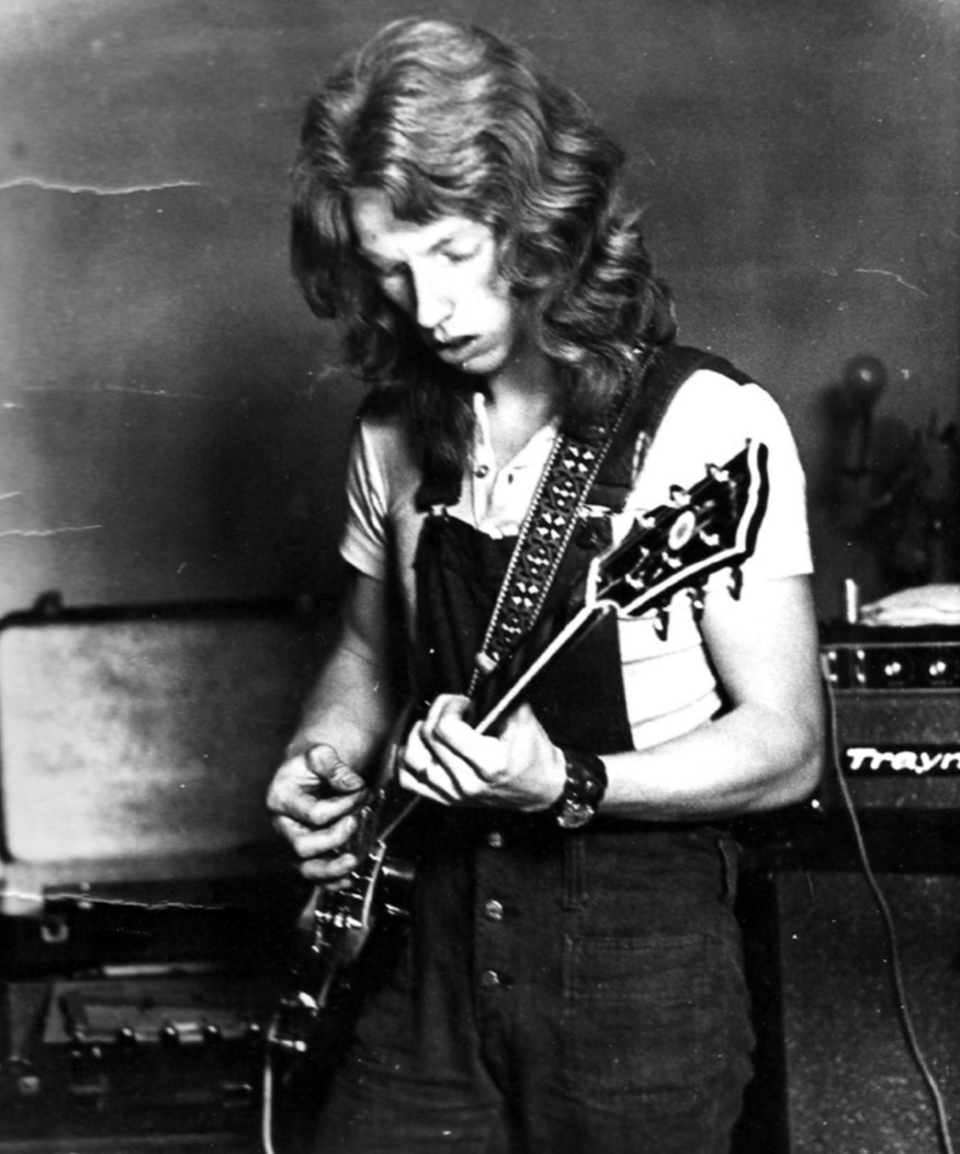
What happened after the band stopped? Were you still in touch with other members? Is any member still involved with the music? Do you know if members participated in other bands back in the 70s after It’s All Meat?
We were struggling financially. The kicker is when we showed up at a rehearsal and all of our equipment was missing. We suspected Jack London took it to try and make up his investment. Sadly Rick Aston and Norm White passed away in their 40’s. I’m still in touch with Jed MacKay and Rick McKim. Jed has received awards producing children’s music for TV Ontario. Rick has written and produced a musical plus many other endeavors. He has a website – www.rickmckimmusic.com. I don’t think Jed or Rick ever were in bands after It’s All Meat. I continued to be in many bands crossing several genres to this day.
Looking back, what was the highlight of your time in the band? Which songs are you most proud of? Where and when was your most memorable gig?
I think it had to be opening for Muddy Waters at The Rock Pile in Toronto, Canada. There was a good crowd of about 5,000. As soon as they heard the opening chord of Norm’s Strat for the song ‘Feel It’ the crowd roared with approval. It still gives me goosebumps. They were incredibly loud but didn’t drown out It’s All Meat. No one could ever do that! I felt sorry for Muddy after our set.
Is there any unreleased material by It’s All Meat or anything else related to your music career?
It’s All Meat re-issued the Columbia album under the Hallucinations label in 2000. This re-issue was a full gatefold with the ‘Feel It’ single including un-released material such as ‘Astrology,’ ‘If Jesus Were Alive Today,’ ‘Can’t Get Together,’ ‘I Don’t Need You Above Me Anymore’ (my favorite), and ‘Pity In The City’. You can still buy this. There have been other re-issues under different labels as well. Question Mark and the Mysterians covered and released our ‘Feel It’ single. I personally have hundreds of songs which have not yet been released. My catalogue spans many genres. rock, country, salsa, folk, you name it.
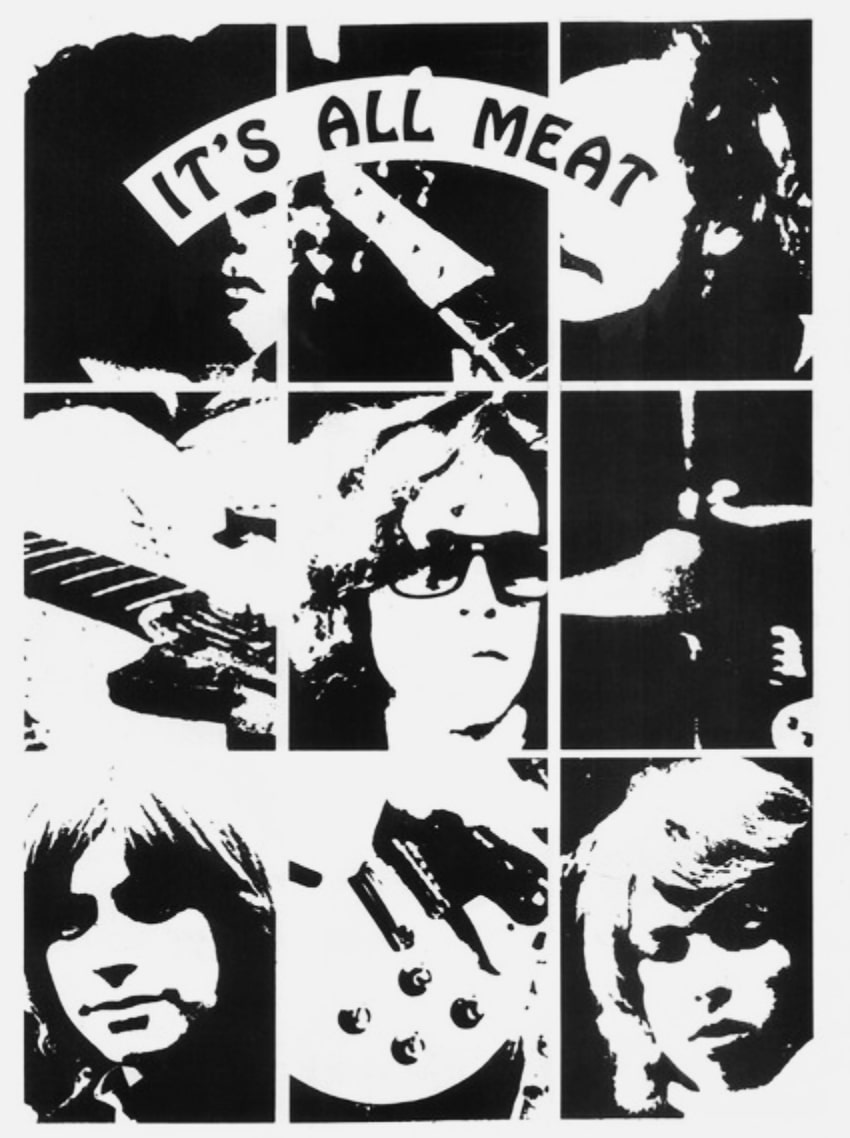
You have been in dozens of bands later on. Would love to hear about that….
Here are some of the names. They seem to have their 15 minutes of fame and then fade away. I was more of a working musician traveling mostly the Southeastern United States in these bands.
Men Behaving Badly
Monroe Station
Steel Bridge
JT Curtis and the Silver Eagles
Cowford County
Cross Canyon
J Collins Band – played the CMA Festival in Nashville – 2013
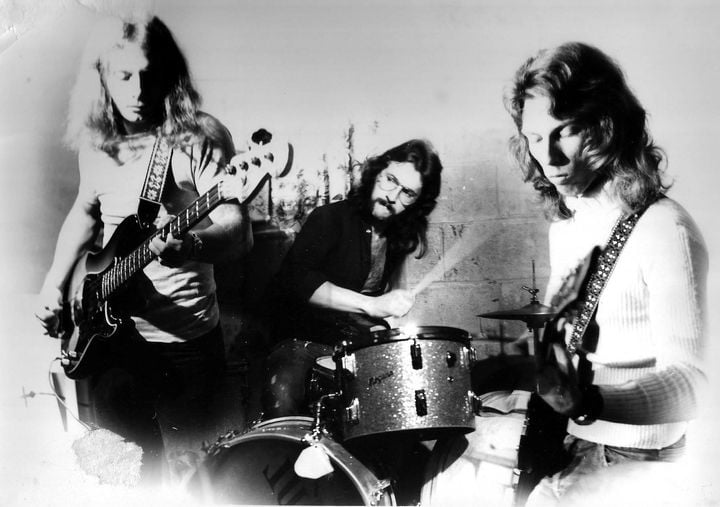
Tell us more about Chrome Yellow which released two albums. It was recorded at Darkhorse Studios just outside of Nashville in Leipers Fork. Freddy Wall, guitarist for Robert Palmer, produced that album. Shawn Fitchter played drums.
I always wanted to move from being a player to writing music throughout the years so I took it seriously in the 90’s. I wrote a bunch of songs on piano and guitar but had no lyrics to go with the music. I hooked up with a frontman named Charlie Gardner. He developed lyrics and melody for all of Chrome Yellow’s music. Chrome Yellow produced two albums, ‘It’s What’s Next’ and ‘Extra Strength’. This music was recorded in Tampa, FL and produced by Wes Styles who now resides in Los Angeles. The solo album under Charlie Gardner was recorded at Darkhorse Studios. Chrome Yellow played the House Of Blues in Orlando, FL several times and also were invited to play SXSW (South By Southwest) a yearly music festival in Austin, TX several times. Somewhere along this journey the nickname “Stayne” was given me and it lingered during this time period.
What currently occupies your life?
Besides writing and producing my own music now I have enjoyed building a few houses from scratch. It’s something that was on my “bucket list” years ago. I have a house by the beach, which I built, in the Florida panhandle now. You just can’t beat the weather here!
Thank you for taking your time. Last word is yours.
I just want to take this moment and thank, with all of my heart, all of the current and new fans from all over the world. It’s humbling to see the music appreciation last for so long and capture new music lovers along the way. We knew we had something back then. Our fans knew it as well. And now it keeps spreading. Thank you!
Klemen Breznikar

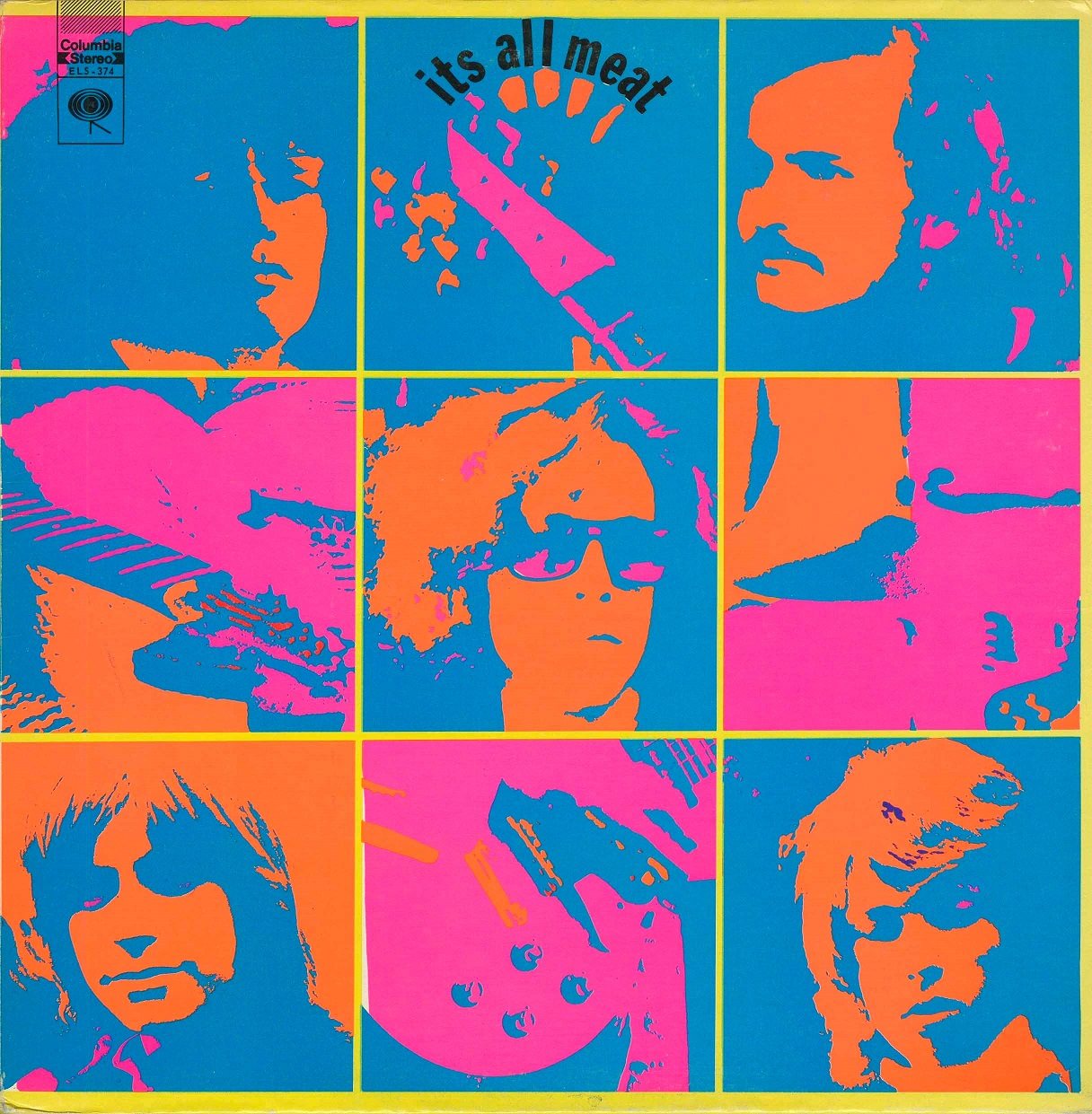



It was a pleasure to work with Klemen. Nice to see IAM is still breathing!
One of the best Candian’s band.
It’s All Meat – 1970 vinyl gatefold full album reissue on Guerssen Records – on sale now!
https://guerssen.com/product/its-all-meat/